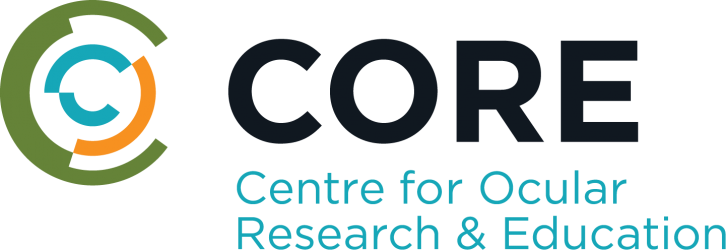Scientific Presentations
2025
Garg P, Shokrollahi P, Phan CM, Jones L. 3D printed contact lenses for the delivery of polyvinyl alcohol as a wetting agent The Association for Research in Vision and Ophthalmology Annual Meeting, Salt Lake City, May 7, 2025 [ Show Abstract ]
Purpose
To print a proof-of-concept 3D printed contact lenses to release polyvinyl alcohol (PVA) as a wetting agent, using 3D printing technology.
Methods
A model CL was designed using a computer-aided design software (FreeCAD 0.19) and 3D-printed using a commercial masked-stereolithography 3D printer. The printer was retrofitted with a humidity and temperature control kit to enable printing at ~95% humidity and 37°C. The polymer solution consisted of 10% (w/v) GelMA, 5% (w/v) PVA as a wetting agent, a photoinitiator, and yellow dye as a light absorbing agent to reduce unwanted light leaks. These 3D printed lenses were washed with warm PBS to remove any uncured polymer solution and post-cured with UV light. The print quality was assessed by determining the ratio between the theoretical area vs the actual printed area and the theoretical circumference vs the actual printed circumference. To study the PVA release from these CLs, they were incubated in glass vials with gentle agitation with 8 mL PBS at 35°C. At each indicated time point 300 µL of the solution was removed for detection of PVA and replaced with fresh PBS. The release kinetics was studied by different mathematical models using GraphPad software.
Results
The CLs were 3D printed in an hour and the print quality scores were 0.96 and 1.04 for area and circumference ratios respectively. The minimum thickness for the lenses that was reliably printed each time using the current 3D printing setup was 400 µm. Around 4711 µg of PVA was released over the study duration of 8 hours, supporting our concept PVA-loaded 3D printed lenses. The release kinetics showed high linearity with Higuchi’s model which describes the release rate of drugs from matrix systems based on diffusion.
Conclusions
This study attempted to print a proof-of-concept 3D printed contact lens that can release PVA from GelMA. Also, these 3D printed contact lenses displayed a good print quality score. Future work will focus on optimizing the thickness and transparency of these lenses as well as tuning the release kinetics of PVA.
Phan C, Walther H, Ho B, Jones L. Development of a novel in vitro blink model for measuring prelens non-invasive break-up time
The Association for Research in Vision and Ophthalmology Annual Meeting, Salt Lake City, May 8, 2025 [ Show Abstract ]
Purpose
To develop an in vitro blink model for measuring prelens non-invasive break-up time of contact lenses with a keratograph.
Methods
The model was designed using CAD (computer-aided design) software and fabricated using a combination of 3D printing, CNC (computer numerical control) machining, and molding processes. The base structure of the eyeball was 3D-printed, and the front surface of the eyeball was cast using acrylic resin mixed with graphite powder in an ultrasmooth polydimethylsiloxane (PDMS) mould. The lower eyelid was designed to hold the eyeball and the lower tear meniscus. The base structure of the eyelid was 3D-printed using flexible resin (Flex 50A) on the FormLabs 3B (Formlabs Inc., Somerville, MA, USA), and then moulded into its final shape with polyvinyl alcohol. The blink speed of the model was set to 150 mm s-1 for both opening and closing. The model’s ability to generate a stable tear film over a contact lens (senofilcon A) was validated using non-invasive keratographic break-up time (NIKBUT) with the OCULUS Keratograph 5M. 20 µL of phosphate-buffered saline (PBS) is added to the upper eyelid using a pipette, and the model is allowed to equilibrate for three blinks before each measurement.
Results
The resulting eyeball is black in the central corneal region, providing the necessary contrast to reflect the concentric rings projected by the keratograph. During each blink, the hydrogel in the upper eyelid comes into contact with the lower tear meniscus and evenly distributes the tear fluid across the eyeball during the upward motion of the blink. Without a contact lens, the tear film breaks immediately over the hydrophobic acrylic surface of the eyeball. The NIKBUT for senofilcon A ranged from approximately 5 to 7 seconds, aligning with clinical observations. The model also includes a fluid reservoir located in the lower eyelid, used to rehydrate the hydrogel. Additionally, two inlets can be attached to the lower eyelid to control fluid flow into and out of the model.
Conclusions
The developed blink model consistently forms a tear film over a contact lens during the upward blink motion, using the lower tear meniscus as the fluid source.
Shokrollahi P, Garg P, Hui A, Phan,C, Jones,L. PVA-Based Hydrogel Inserts for Atropine Delivery for Myopia Treatment The Association for Research in Vision and Ophthalmology Annual Meeting, Salt Lake City, May 4, 2025 [ Show Abstract ]
Purpose
Myopia progression is a global problem, with 50% of the world’s population predicted to be myopic by 2050. This project aimed to develop atropine (ATR)-releasing ocular inserts based on polyvinyl alcohol (PVA) hydrogels for the treatment of myopia, which could be complementary to other myopia control methods, such as spectacles or contact lenses.
Methods
PVA was dissolved in water at 80°C to prepare a 10% (w/v) solution. The solution was divided into two parts. ATR was added to one part to give 0.6% (w/v) concentration, and the other part acted as a control. Both groups were transferred to a silicon mold (5.5mm diameter, 0.2mm height, ~100µl) and subjected to six freeze-thaw cycles, alternating between freezing at -20°C for 16 hours and thawing at room temperature for 8 hours
Mechanical properties were studied via a compression test (TA instruments, Hamilton, USA), and the morphology was assessed using scanning electron microscopy (Quanta FEG 250, FEI, USA). The release of atropine was then measured in 1mL of phosphate-buffered saline every 30 minutes for 6 hours.
Results
SEM analysis revealed a highly interconnected porous structure and a narrow pore size distribution (12±8µm, Figure 1A). The hydrogels displayed about 0.86 kPa compression modulus and 21.81 kPA compression strength at 30% strain (Figure 1B) and withstood 5 compression cycles with minimal changes in modulus. The discs released about 25% of the initial ATR loaded (~600 µg) in the first 30 min and about 50% in 1 hour. Nearly, 100% of the cargo was released in 3.5 hours (Figure 1C). The release profile followed first-order kinetics (R2 = 0.9628).
Conclusions
The open pore network of the discs can accommodate water and improve the elastic soft “feel” of the insert, while being structurally robust and easy to handle. This hydrogel insert based on PVA, a polymer with FDA approval for biomedical applications, can support the gradual release of ATR up to 3.5 hours and helps avoid the side effects of 1% ATR eye drops, while providing a similar cumulative concentration of the drug to the eye. Future studies will focus on optimizing parameters to extend the release duration.
Walsh K, Vega J, Chisholm R, Cvarch B, Schwiegerling J, Luensmann D, Marullo R. Performance of two contact lens designs in a clinical setting and through computational optical modelling Global Specialty Lens Symposium, Las Vegas, Jan 17, 2025





